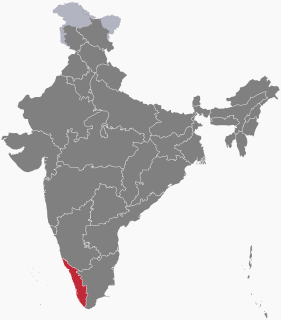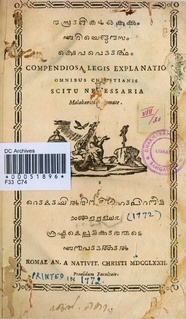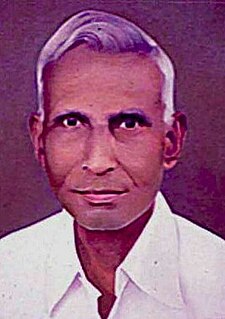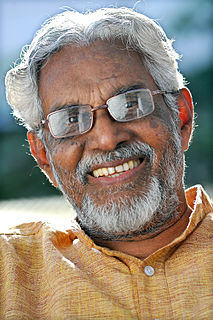Related Research Articles

Malayalam is a Dravidian language spoken in the Indian state of Kerala and the union territories of Lakshadweep and Puducherry by the Malayali people. It is one of 22 scheduled languages of India and is spoken by 2.88% of Indians. Malayalam was designated a "Classical Language of India" in 2013. Malayalam has official language status in Kerala, Lakshadweep and Puducherry (Mahé), and is spoken by 34 million people in India. Malayalam is also spoken by linguistic minorities in the neighbouring states; with significant number of speakers in the Kodagu and Dakshina Kannada districts of Karnataka, and Nilgiris and Kanyakumari, districts of Tamil Nadu. It is also spoken by the Malayali Diaspora worldwide, especially in the Persian Gulf countries, due to large populations of Malayali expatriates there.

Malayalam, the lingua franca of the Indian state of Kerala and the union territories of Lakshadweep and Puduchery, is one of the six Classical languages of India. Malayalam literature comprises those literary texts written in Malayalam, a South-Dravidian language spoken in the Indian state of Kerala. The first travelogue in any Indian language is the Malayalam Varthamanappusthakam, written by Paremmakkal Thoma Kathanar in 1785. Malayalam literature has been presented with 6 Jnanapith awards, the second-most for any Dravidian language and the third-highest for any Indian language.
Indian literature refers to the literature produced on the Indian subcontinent until 1947 and in the Republic of India thereafter. The Republic of India has 22 officially recognised languages.

Thunchaththu Ramanujan Ezhuthachan was a Malayalam devotional poet, translator and linguist from Kerala, south India. He has been called the "Father of Modern Malayalam", or, alternatively, the "Father of Modern Malayalam Literature", or the "Primal Poet in Malayalam". He was one of the pioneers of a major shift in Kerala literary production. The number and circulation of his texts far outdo that of any other poet of premodern Kerala.
Manipravalam is a macaronic language found in some manuscripts of South India. It is a hybrid language, typically written in the Grantha script, which combines Sanskrit lexicon and Dravidian morpho-syntax. According to language scholars Giovanni Ciotti and Marco Franceschini, the blending of Tamil and Sanskrit is evidenced in manuscripts and their colophons over a long period of time, and this ultimately may have contributed to the emergence of Manipravalam. However the 14th century Sanskrit work Lilatilakam states that Manipravalam is a combination of Dravida and Sanskrit. Generally it is agreed that it was a combination of Old Malayalam with Sanskrit.

The culture of Kerala has developed over the past millennia, influences from other parts of India and abroad. It is defined by its antiquity and the organic continuity sustained by the Malayali people. Modern Kerala society took shape owing to migrations from different parts of India and abroad throughout Classical Antiquity.

Kavalam Narayana Panicker was an Indian dramatist, theatre director, and poet. He has written over 26 Malayalam plays, many adapted from classical Sanskrit drama and Shakespeare, notably Kalidasa's Vikramorvasiyam, Shakuntalam (1982), Bhasa's Madhyamavyayogam (1979), Karnabharam, Uru Bhangam (1988), Swapnavasavadattam, and Dootavakyam (1996). He was the founder – director of theatre troupe, Sopanam, which led to the foundation of Bhashabharati: Centre for Performing Arts, Training and Research, in Trivandrum.
Panikkar is a common spelling of the title of Panicker used in India, specifically in the state of Kerala, which roughly comprises the former (British) Madras Presidency district of Malabar and the princely states of Cochin and Travancore, The title was usually conferred on those who are proficient in Kalaripayattu and majority of them belong to Nair community.
Kavalam Madhava Panikkar, popularly known as Sardar K. M. Panikkar, was an Indian statesman and diplomat. He was also a professor, newspaper editor, historian and novelist. He was born in Travancore, then a princely state in the British Indian Empire and was educated in Madras and at the University of Oxford.

Assamese literature is the entire corpus of poetry, novels, short stories, plays, documents and other writings in the Assamese language. It also includes the literary works in the older forms of the language during its evolution to the contemporary form and its cultural heritage and tradition. The literary heritage of the Assamese language can be traced back to the c. 9-10th century in the Charyapada, where the earliest elements of the language can be discerned.
Panicker is a title or last name. Panicker is an ethnic group belonging to the Hindu religion, who live in the South Malabar and central parts of the Indian state of Kerala.In the erstwhile Kingdom of Travancore, many families from Syrian Christian community were also bestowed with the title for exemplary deeds mostly with regards to the knowledge in Kalari.

Depending on the methods of counting, as many as three hundred versions of the Indian Hindu epic poem, the Ramayana, are known to exist. The oldest version is generally recognized to be the Sanskrit version attributed to the sage Narada, the Mula Ramayana. Narada passed on the knowledge to Valmiki, who authored Valmiki Ramayana, the present oldest available version of Ramayana.
Kaniyar is a caste from the Indian state of Kerala. There are regional variations in the name used to define them. They are listed under the Other Backward Communities (OBC) by the Kerala Government.

Kudiyirikkal Narayanan Ezhuthachan, commonly known as Dr.K.N.Ezhuthachan was an Indian writer and scholar of Malayalam literature. He was one among the principal followers of the idea of social impact on literature. Ezhuthachan supported Marxist literary criticism and interpreted Indian literary works based on Marxist aesthetics. He won the Sahitya Akademi Award for his work Keralodayam, a long narrative poem written in Sanskrit. He is the first Malayali to win Sahitya Akademi Award in sanskrit literature. He died on 28 October 1981 while delivering a lecture at Calicut University.
Kodungallur Kovilakam, is a palace of the royal family of the late [medieval] Kingdom of Kodungallur (Cranganore), in the modern-day Indian state of Kerala. Kodungallur was a feudal principality subordinate to the rulers of the Kingdom of Cochin from the later half of the eighteenth century until Indian independence. The Kingdom of Kodungallur was under the protection of the Dutch government after 1707 for a few years before returning to its allegiance to the Zamorin. The Kodungallur Royal Family had two branches, at Chirakkal Kovilakam and at Puthen Kovilakam.
Kodungallur Kunjikkuttan Thampuran also transliterated as Kotungallur Kunhikkuttan Thampuran, was a Malayalam poet and Sanskrit scholar lived in Kerala, India. His birth-name was Rama Varma. He is famous for his single-handed, word-by-word translation of entire Mahabharata within 874 days. He is commonly known as Kerala Vyasa, meaning Vyasa of Kerala.

Puthussery Ramachandran Pillai was an Indian poet of the Malayalam language. He was a scholar of Dravidian linguistics and a professor of Malayalam for more than three decades. On 14 March 2020, he died of age-related illnesses.

Niranam Thrikkapaleeswaram Dakshinamurthy Temple, is an ancient Hindu temple dedicated to Lord Shiva is situated on the banks of the Pampa river at Niranam of Pathanamthitta District in Kerala state in India. This temple is a classic example of the Dravidian style of architecture. The temple is the abode of Dakshinamurthy. The deity of Thrikkapaleeswaram is located in main Sanctum Sanctorum facing east. According to folklore, sage Parasurama has installed the idol. The temple is a part of the 108 famous Shiva temples in Kerala. This is one of the three Thrikkapaleeswaram temples mentioned in 108 Shiva temples. Two other temples situated in Peralassery in Kannur district and Nadapuram in Kozhikode district.
Middle Malayalam is the period of the Malayalam language spanning from 13th century to 15th century AD.
References
- 1 2 Menon, A. Sreedhara (1979). Social and cultural history of Kerala. Sterling. p. 335.
- 1 2 3 4 Freeman, Rich (2003). "Literary Culture of Pre-Modern Kerala". In Pollock, Sheldon I. (ed.). Literary Cultures in History: Reconstructions from South Asia. University of California Press. pp. 465–468. ISBN 9780520228214.
- 1 2 3 4 "The Niranam Poets". Public Relations Department Kerala State Government. Archived from the original on 14 October 2014.
- ↑ Datta, Amaresh (1987). Encyclopaedia of Indian Literature: A-Devo. Sahitya Akademi. p. 464. ISBN 9788126018031.
- ↑ Śarmā, Rāma Karaṇa; Narang, Satya Pal (1995). Modern evaluation of the Mahābhārata: Prof. R.K. Sharma felicitation volume. Nag Publishers. p. 267. ISBN 9788170812913.
- Singh, Kumar Suresh (2003). People of India. 26. Anthropological Survey of India. p. 717.